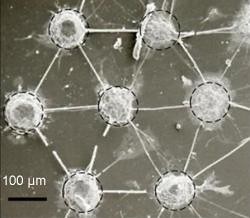Brain cells can be enticed into forming uniform functioning patterns using a nano-engineering trick.
The technique could allow the development of sophisticated biological sensors that use functioning brain cells, the researchers say. This type of device would identify a compound – a deadly nerve agent or poison, for example – by measuring its effect on a functioning network of neurons.

A team led by Yael Hanein of Tel Aviv University in Israel used 100-micrometre-wide bundles of nanotubes to coax rat neurons into forming regular patterns on a sheet of quartz.
The neurons cannot stick to the quartz surface but do bind to the nanotube dots, in clusters of about between 20 and 100. Once attached, these neuron bundles are just the right distance from one another to stretch out projections called axons and dendrites to make links with other clusters nearby. Finding ways to connect to individual neurons in similar arrangements would be even more useful.
In experiments they last longer than other artificial networks, surviving for up to 11 weeks.

Brian Wang is a Futurist Thought Leader and a popular Science blogger with 1 million readers per month. His blog Nextbigfuture.com is ranked #1 Science News Blog. It covers many disruptive technology and trends including Space, Robotics, Artificial Intelligence, Medicine, Anti-aging Biotechnology, and Nanotechnology.
Known for identifying cutting edge technologies, he is currently a Co-Founder of a startup and fundraiser for high potential early-stage companies. He is the Head of Research for Allocations for deep technology investments and an Angel Investor at Space Angels.
A frequent speaker at corporations, he has been a TEDx speaker, a Singularity University speaker and guest at numerous interviews for radio and podcasts. He is open to public speaking and advising engagements.

